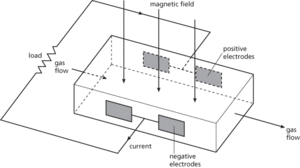The study of the interactions between a conducting fluid and a magnetic field. MHD is important in the study of controlled thermonuclear reactions in which the conducting fluid is a plasma confined by a magnetic field. Other important applications include the magnetohydrodynamic power generator. In the open-cycle MHD generator a fossil fuel, burnt in oxygen or preheated compressed air, is seeded with an element of low ionization potential (such as potassium or caesium). This element is thermally ionized at the combustion temperature (usually over 2500 K), producing sufficient free electrons (e.g. K → K++e) to provide adequate electrical conductivity. The interaction between the moving conducting fluid and the strong applied magnetic field across it generates an e.m.f. on the Faraday principle, except that the solid conductor of the conventional generator is replaced by a fluid conductor. The power output per unit fluid volume (W) is given by W=kσv2B2, where σ is the conductivity of the fluid, v is its velocity, B is the magnetic flux density, and K is a constant. Devices of this kind are in use in some power stations, where they are suitable for helping to meet high short-term demands and have the ability to increase the thermal efficiency of a steam-turbine generator from about 40% to 50%. In experimental closed-cycle systems the fluid is continuously recirculated through a compressor; the fluid consists of a heated and seeded noble gas or a liquid metal. MHD is also important in understanding the magnetic fields of the earth, the sun, and other stars, particularly pulsars, and the magnetosphere of the earth and of other planets with magnetic fields.

Magnetohydrodynamics. Magnetohydrodynamic generator.
A theory that treats the motion of a plasma (ionized gas) in the presence of a magnetic field as a fluid with a high electrical conductivity. Although approximate, the theory works well for tenuous plasmas on large scales. Under these conditions magnetic forces effectively tie the charged particles (usually protons and electrons) that compose the plasma to the magnetic field; the plasma and magnetic field are then said to be ‘frozen’ together and the magnetic field moves with the plasma. Depending on the relative energies of the magnetic field and plasma, the magnetic field may control the motion of the plasma, as in a solar coronal streamer or solar prominence, or the plasma may drag the magnetic field with it, as in the solar photosphere or solar wind. Stellar and planetary dynamos are understood using MHD. The theory of MHD was developed by H. O. G. Alfvén in 1942. MHD fluid waves are known as Alfvén waves.
The science of relating magnetic fields, mainly mathematically, within a moving conducting medium. It is mainly applicable to the Earth’s core, where the geomagnetic field is generated by the motion of magnetic lines of force that are ‘frozen’ within a moving, electrically conducting medium, but it is also applicable to all systems involving the fluid motion of electrically conducting materials within a magnetic field.
- fluvial geomorphology
- fluvial processes
- fluvial system
- fluviatile
- fluvic horizon
- fluvio-glacial
- fluviokarst
- fluvisols
- flux
- flux collector
- flux density
- flux, doctrine of
- fluxgate magnetometer
- fluxion
- fluxional molecule
- fluxmeter
- fluxoturbidite
- flux quantum
- flux tube
- flux unit
- fly
- flyaround
- flyback
- fly-by
- fly by wire